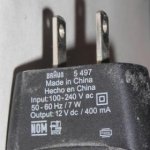Fishn sparky
Member
- Location
- Washington State
Good evening sirs,
I have a student in class who is Russian and recently went back home. He tried an experiment that failed and asked me to explain why. I can't because I'm not familiar with European voltages. Apparently, Russian voltage operates at 220v. My student tried to use a rheostat dimmer and turned down the voltage to 120v. He then plugged in a wall charger that solely operates at 120v and it didn't work. Why?
I do know that the frequency is 50hz instead of 60hz and that rheostat dimmers are just a variable resistor inside but I can't explain why this doesn't work. Any explanations? Thoughts are always welcome and if this is a simple answer, I apologize!
I have a student in class who is Russian and recently went back home. He tried an experiment that failed and asked me to explain why. I can't because I'm not familiar with European voltages. Apparently, Russian voltage operates at 220v. My student tried to use a rheostat dimmer and turned down the voltage to 120v. He then plugged in a wall charger that solely operates at 120v and it didn't work. Why?
I do know that the frequency is 50hz instead of 60hz and that rheostat dimmers are just a variable resistor inside but I can't explain why this doesn't work. Any explanations? Thoughts are always welcome and if this is a simple answer, I apologize!

